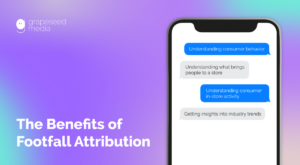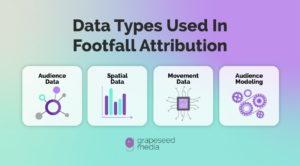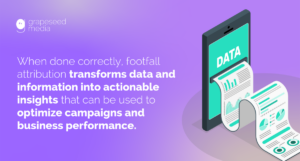The retail world has changed significantly over recent years with evolving consumer habits and expectations shaping the industry. If you want to optimize your business operations, it’s crucial to understand consumer behavior, both online and off.
When it comes to e-commerce, a business can use digital marketing attribution to track and measure how various digital channels contribute to their sales efforts and conversions. However, evaluating the effectiveness of a digital campaign in driving foot traffic to a physical store necessitates a completely different set of skills. This is where footfall attribution comes into the mix.
Footfall attribution (also known as foot traffic attribution) helps retailers keep track of how many people are coming into the store and what is driving them there. It involves tracking and analyzing the foot traffic within a store and attributing it to specific marketing campaigns, promotions, or store layouts.
By using data from footfall attribution, retail marketers can gain valuable insights into customer behavior, making it easier to make informed decisions regarding where they should be making investments in their business to maximize returns. Below, we explore how footfall attribution works and how to leverage footfall attribution effectively to gain insights into customer behavior.

Footfall Attribution: An Overview
Footfall attribution helps businesses measure and optimize the impact of online campaigns in the offline world in various ways:
Analyzing Foot Traffic to Understand Consumer Behaviour
Footfall attribution allows businesses to analyze foot traffic and gain valuable information about their customers. Retailers can gain insights into various aspects of consumer behavior such as demographics, buying habits, and expenditure patterns. Such data can help businesses make informed decisions about their marketing initiatives, operational efficiency, and facility management.
For instance, if a company notices that a significant proportion of their customers are millennials and Gen-Zers, they may opt to tailor their marketing efforts to attract more young consumers. Similarly, a store’s footfall can be used to determine the busiest times of the day or week. With this information, a business can optimize staffing levels to ensure they have enough employees on hand during peak periods.
Understanding What Brings People to a Store
In addition to tracking the number of people going in and out of a store, footfall attribution can help businesses understand what brought customers into the store in the first place so they can optimize their multi-channel marketing strategy. For example, footfall attribution will help a business understand how different digital marketing campaigns or promotions impact in-store visits. How? After a customer is exposed to an online ad, whether it be a display, CTV, audio, etc.., their phone’s location data can attribute a visit to the digital campaign.
By tracking footfall data alongside sales data, businesses can determine which marketing campaigns or promotions were most effective at driving foot traffic. This, in turn, allows them to improve and optimize campaigns, focus their resources on the most effective ones, and improve their return on investment.
Analyzing Consumer In-Store Activity
Footfall attribution can help stores figure out what people are doing while they are in a store. For instance, a store can use sensors to track which areas of the store people are spending the most time in, thereby gaining valuable information that can be used to optimize product placement and marketing strategies.
Gaining Insights Into Industry Trends
Footfall attribution can provide insights into industry trends like seasonal shifts in consumer behavior, regional changes in preferences, or broader macroeconomic influences such as economic downturns or pandemics. These trends can help businesses make informed decisions about where to invest their resources and determine which products offer the greatest value during certain periods. For example, a business can use footfall attribution data to identify when there’s an economic downturn or pandemic and adjust their operations accordingly.
Footfall attribution is a powerful tool that enables businesses to optimize their operations and marketing strategies — it improves the decision-making process, giving brands a competitive edge. However, to get the most out of it, you must first understand the various data types that provide a framework and insights for analyzing foot traffic patterns in order to drive campaign and business performance.
Data Types Used In FootFall Attribution
The following are data types used in footfall attribution:

Audience Data
Audience data consists of data linked to mobile advertising IDs based on audience online and offline behavior. This data includes app usage, demographics, location visits, purchases, and preferences. A variety of sources prove useful to gathering data, including mobile apps, websites, and offline interactions with businesses.
By combining both online and offline data, businesses can get a holistic view of consumers’ behaviors and preferences, which can help advertisers make informed decisions about their advertising campaigns. For example, if an advertiser wants to target people who are interested in financial services, they can use app usage data to target people who use financial services apps frequently.
Movement Data
Movement data uses background mobile location data from apps that users have agreed to share, even when the apps are not in use. The data is gathered using various technologies such as Bluetooth, beacons, Wi-Fi, accelerometers, and GPS, and it provides precise longitude and latitude rather than IP addresses.
This data provides insights into the target audience’s location and movement patterns, helping advertisers to create better-performing campaigns. For instance, an advertiser who wants to target people who visit a specific location frequently can use movement data to identify those people’s location and movement patterns and target them with relevant ads.
Spatial Data
Spatial data connects audience context (for example, weather and purchase history) and interests to movement data, thereby predicting consumer movement while maintaining privacy. The data is collected using geolocation technology and provides insights into the target audience’s movement patterns. For more precise targeting, spatial data can be combined with building footprints.
Audience Modeling
Audience modeling employs lookalike data to predict the impact of an ad on in-store visits, i.e., it provides insights into the potential impact of an advertising campaign on the target audience. Data for audience modeling is gathered using predictive analytics, which analyzes the target audience and identifies individuals who fit into that audience.
If an advertiser wants to target people who are similar to their current customers, they can use audience modeling to identify people who are likely to visit their store after seeing their ad.
Ultimately, the various data types are all important tools for understanding footfall attribution. By analyzing them, you can gain insights into consumer behavior and the factors that are most likely to influence foot traffic patterns.
How to Use Footfall Attribution Effectively
To use footfall attribution effectively, it’s important to follow a systematic approach that allows you to make data-driven decisions. 
Here are some steps to consider:
- Set measurable goals: Before you start tracking footfall, you should determine what you want to achieve. For example, you may want to increase footfall by a certain percentage or increase sales in a particular store category. Setting clear and measurable goals will help you to identify which metrics are most important and make it easier to track your progress over time.
- Collect and analyze data: Collecting and analyzing data is the cornerstone of effective footfall attribution. Therefore, you should be tracking and analyzing store traffic patterns, sales data, and customer behavior data to gain insights into how your customers behave and what influences footfall.
- Pay attention to the most effective marketing channels: Footfall attribution can help you determine which marketing channels are most effective at driving foot traffic, so it’s critical to capitalize on this. For example, attribution can assist you in tracking how many people visit your store after seeing your social media ads, programmatic OOH, email marketing, or digital video campaigns. As such, make sure to track sales and footfall data to determine which channels are most effective for your company.
- Optimize store layout and merchandising strategies: Use the information you gather from analyzing foot traffic data to determine which areas of the store are most popular and which products attract the most attention. This way, you can tweak your store layout and merchandising strategies to maximize foot traffic and sales.
- Personalize the shopping experience: Use footfall attribution to personalize the shopping experience for your customers. By segmenting them and tracking their online and offline behavior, you can tailor your marketing messages to your customers’ needs and preferences. You can also use loyalty programs to reward customers and encourage repeat visits.
By implementing these steps, you can turn data and information into actionable insights that help you to optimize your campaigns and increase performance.
Understanding Campaign Impact with Footfall Attribution
With a significant number of retail purchases still happening offline, marketers need to connect their digital campaigns to offline consumer activity. Footfall attribution is one way of addressing this issue, helping businesses connect ad exposure to real-world consumer behavior. When used expertly and strategically, footfall attribution carries specialized benefits for marketers and brands.
Speaking of expertise, having a partner like Grapeseed can help you navigate the world of footfall attribution while maximizing ROI and meeting your business objectives. You can schedule a strategy chat with the Grapeseed team to learn more about using footfall attribution and how to optimize future campaigns accordingly.






